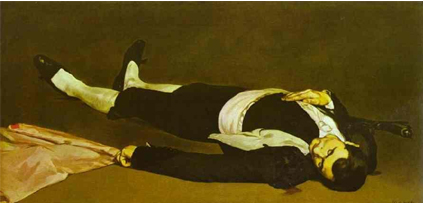An exhibition of the paintings of Edouard Manet at Ordrupgaard in Copenhagen.
HE IS THE model of sartorial elegance, in his sleek black jacket and knickerbockers, his knee-high white stockings and his shiny black shoes. One hand is folded neatly across his chest; the other lies by his side, clutching the matador's cape that gives away both his nationality and profession. The ring on his little finger gleams, a muted highlight. He is, indeed, elegant. He is also dead. At first sight he looks as though only sleeping, but there are fresh bloodstains on the sand and more on his crisp white shirt.
Death does not come any more beautiful than this. Edouard Manet painted The Dead Toreador a year before he visited Spain for the one and only time in his life - he was there in 1865 and stayed a mere 10 days, as his friend Theodore Duret tells us, because he could not abide the food - yet it is a painting that already testifies to Manet's immense admiration for the great Spanish masters. There is a hint of Zurbaran, in the dulled range of background colours, earthy and dark; there is Velasquez's focus on the single figure. But there are touches, too, of Frans Hals, in the crisp contrast between black and white that is the leitmotif of the painting, and almost as much its subject as the dead man himself.
The Dead Toreador is owned by the National Gallery of Washington, but it hangs for the moment in a toplit, neo-classical gallery adjoining a secluded mansion in one of the grander suburbs of Copenhagen. Ordrupgaard, built for a Danish art collector in 1918, has been a municipal art gallery since 1951. 'Edouard Manet', a temporary exhibition of some 50 paintings borrowed from all...

The Painter of Fragments
26-09-1989

